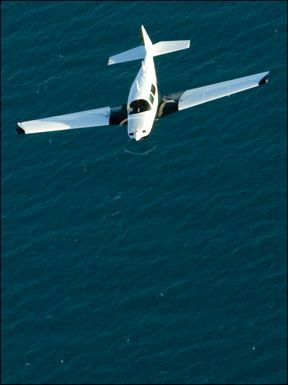Of age mellows people, the same thing might be said of airplanes, at least if the airplane in question is Mooneys M20K series. The airplane arrived in the GA market at a time when turbocharging was relatively new and the demand for high flying aircraft was thin.
Mooney didnt get the M20Ks turbocharging system right on the first try and the airplane developed a reputation as a maintenance hog. Thirty years later, that reputation has been mostly burnished and the fact that the M20K bores along between 160 and 200 knots on relatively little fuel has improved the models used price.
Still, the cabin is small and with a single door, hard to get into. For that reason and others, Mooneys have a bit of cult status to them. They are in no way everymans airplane in the way that a Cessna or a Piper is. But if cruising fast yet miserly is your wont, the M20K models-the 231, the 252 and the Encore-are strong contenders.
Model History
Mooney came into the turbocharging game relatively late compared to other manufacturers. In 1966, Cessna pioneered the market with the T210 and made a strong showing in the single-engine, high-altitude market. Beech brought out the V35TC in 1966, but it was never as strong a seller as the A36. Mooney wasnt completely flat footed during the 1960s, introducing the 310-HP M22 Mustang in 1967, a big brute of an airplane that was as ugly as it was unsuccessful.
Through the 1970s, Mooney did we’ll with small, efficient airplanes powered by Lycoming four-bangers. Mooneys big breakthrough came in 1977, when the M20J 201 was introduced as the fruit of a clever Roy LoPresti-led aerodynamic cleanup of the venerable F-model. The 201-named for its maximum speed in miles per hour-marked a turning point for Mooney, even if the claimed speed was somewhat optimistic. As early as 1977, Piper had the Turbo Arrow and Mooney realized it needed to compete in this market.
The result appeared in 1979 as the 231-again, named for its top speed-or M20K. It was essentially a 201 with a six-cylinder, 210-HP Continental TSIO-360-GB in place of the 201s 200-HP Lycoming IO-360. The airframe had a lot going for it. It was strongly built of welded 4130 steel, the gear system was all but indestructible and the handling was mannerly, easily flown by a pilot with minimal retract experience. By modern standards, Mooney had a smash hit on its hands. It sold 246 airplanes the first year, outdistancing the 201 by nearly two to one. The fact that the two airplanes were so similar simplified the build process and likely made the project profitable from the first year.
The differences are in minor aerodynamic refinements. The K-models fuel capacity is 10 gallons more than the J-model, and both empty and gross weights are 160 pounds higher. Design-wise, the 231 was exactly what the buyers were looking for: a turbocharged 201.
But if buyers were hoping for the 201s excellent dispatch rate, they got something less. Problems with the 231s Continental engine were several fold and hurt the models initial reputation. The new cowling didnt cool the engine adequately; the fixed-wastegate turbo required constant attention and was easy to mismanage; overboosting and high heat put undue stress on the engine, and it was prone to cracking cylinders and cases.
The connecting rods were prone to failure and the original magnetos were unpressurized, and would arc at high altitude. On top of all this, the TBO of the first engines was a miserly 1400 hours, later upped to 1800 hours, where it still stands.
Even with all these faults-and they were considerable-some owners achieved impressive maintenance reliability by
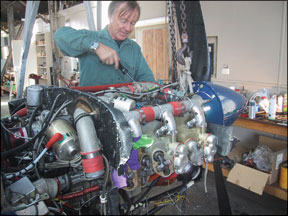
obsessive attention to operating technique. Specifically, that meant careful leaning and attention to cowl flaps and preventive maintenance of the turbo. But not all owners were so careful and premature engine crumps were common.
Improvements
With a couple of years of experience under its belt, Mooney undertook some improvements, adding a split rear cargo seat in 1982, while in 1984, a new variant of the engine -the LB1B, which is approved as a replacement for the GB-was introduced with better cooling and overboost protection. Mooney also included some aerodynamic tweaks that added 3 to 5 knots: sealed nose gear doors, a belly pan, a more streamlined tailcone and removal of one of the vent intakes. The alternate air intake system changed to address reports of icing-induced power loss.
While these fixes certainly helped, the improvements were hardly night and day. By 1986, further retooling produced the 252TSE for Turbo Special Edition. The 252, while still an M20K, is significantly different from the 231. Another variant of the engine was fitted, the -MB1. The induction and cooling systems were reworked and a new intercooled, density-controlled, variable wastegate AiResearch turbocharger replaced the original, fixed wastegate Rajay/Rotomaster unit. Other changes included infinitely adjustable electric cowl flaps to replace the original dual manual flaps. There was a vernier throttle control, more elbow room and new-look radiused windows.
The 231s original 60-amp, 14-volt electrical system was upgraded to a 70-amp, 28-volt system. This was much needed, since a fully loaded K-model could max out the electrics long before the days of moving maps. An electrically driven backup vacuum pump was made standard equipment.
The 252 also got further aerodynamic tweaking in the form of gear doors that fully enclose the wheels when retracted and cover the wells when the gear is extended. The 252 also got an increase in gear-extension speed to 140 knots, up from 132 knots. Maximum speed with gear extended is 165 knots for the 252. In all, 889 231s were produced between its introduction in 1979 and 1985. The 252, introduced in the middle of the GA slump of the 1980s, is less numerous. Production totaled, ironically, 231 airplanes.
The K-model made a brief resurgence in 1997 as the Encore, when Mooney was going through yet another of its many reorganizations. But it was not to be and the model was dropped again in 1998. Meanwhile, the so-called long-body models, specifically the M20M TLS and later the M20R Ovation and Acclaim eventually came to dominate the Mooney line.
Performance
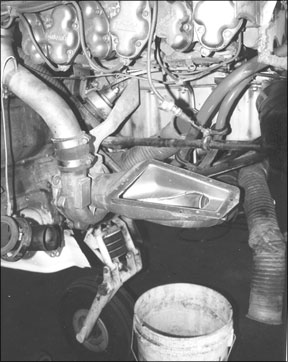
The K-model lives in a league of its own when measured against the narrow market segment of four-place, turbo retractables. At cruise, the 231 outstrips its competitors-the turbo Arrow, the 182 RG and Commander TC-by roughly 20 knots, despite the fact that the 231 MPH (196 knots) top speed isn’t reachable under real-world conditions and probably at all.
Realistic max cruise is about 190 knots for the 231, but 170 to 175 knots is more like it. The 252 is about 10 knots faster, thanks to intercooling. Both M20Ks win the altitude battle as well, with a maximum operating altitude of 24,000 feet for the 231 and 28,000 feet for the 252, versus 20,000 feet for the Cessna and Piper. The Mooneys outclimb the others by about 150 FPM.
Due to physiological considerations, however, high teens to low 20s are the airplanes best envelope. At lower altitudes, turbocharged airplanes arent much faster than their normally aspirated siblings. In fact, the 231 is actually slower than the 201 below 8000 feet, due to cooling drag. The J-model will also outclimb the K-model below 8000 feet.
Many owners operate 252s conservatively. One owner told us that 65 percent power yields 170 knots at 10,000 feet and 200 knots at FL210, burning 11.5 GPH. The 231s numbers are proportionately lower at high altitudes, although the difference lessens the lower one goes.
With 75.6 gallons of usable fuel, the 252 can climb to FL280 and operate a total of 4.9 hours, or just under 990 nautical miles still-air range with reserves. The 231 has comparable range and endurance, but cant fly as high.
231/252 Differences
The improved powerplant installation makes for a significant operational difference between the 231 and 252. The engine still produces 210 HP, but it does so at a markedly lower manifold pressure: 36 inches for the 252 versus 40 inches for the 231, thanks to the improvements in the tuned induction, cooling and turbo systems.
The 252s induction and cooling air intakes are separate from one another. Induction air enters through a NACA scoop on the side of the cowling, is turned 90 degrees to minimize induction icing through inertial separation and passes through a larger, less-restrictive air filter. Its then compressed and run through a 42-square-inch intercooler.
The result is dramatically lower temperatures for the induction air, from 60 degrees F at lower altitudes to 120 degrees F up high. That means more power at higher altitudes and a wider detonation margin. The 231s critical altitude is only 14,000 feet, while the 252s critical altitude is 24,000 feet. In practical terms, this means that the 252 can continue to climb at about 1000 FPM into the mid-20s, can fly higher and is faster once up there.
The most important difference between the 231 and 252 lies in
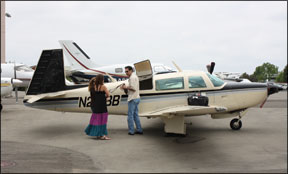
engine management. The revised powerplant installation in the 252 made an enormous difference and makes the 252 a more desirable airplane. Because the 231 has a fixed wastegate, the pilot must constantly monitor manifold pressure and fiddle with the throttle to keep it within limits. Bootstrapping and overboosting are constant worries. Thanks to its automatic wastegate, the 252 doesnt suffer these foibles.
Handling
The 231/252 series handle like typical Mooneys: relatively heavy in roll and pitch, with good stability. The K-models have greater pitch authority, thanks to a slightly larger elevator and the longer engine makes it somewhat nose heavy. That can make flaring a challenge with a forward CG, but nothing like, say, a Cessna 182.
Pitch change with gear extension/retraction is slight, but flap extension produces a nose-down moment. Transition from full flaps to trimmed for go-around takes heavy pressure on the yoke and fast action on the trim. Using the electric trim, anticipation of configuration changes helps reduce pilot effort.
Speed control is essential when approaching and landing any Mooney. Approach too fast and the K-model will float. Try to plant it on the ground and it will fight back, porpoising vigorously and striking the prop if uncorrected. This is a common accident for all Mooneys, not just the K-model.
Because of its ability to fly fast, some owners say the best addition ever devised for Mooneys are speed brakes. These are especially useful for the 231, which doesnt have the 252s higher gear limits. (Speed brakes are standard on 252s.)
Ground handling isn’t great. The airplane is low slung and the Mooneys stretched-out seating position hinders visibility on the ground. It also makes gaining purchase on the brakes difficult. The wing span (36 feet, 1 inch), combined with the wide turning radius of 41 feet, makes negotiating a crowded ramp challenging. One other caution: Many Mooneys suffer damage to the nose gear trunion when towing turn limits are exceeded via power towing. Owners learn to watch the ramp rats carefully.
Payload, Cabin
On paper, the 231 and 252 have the same loading characteristics. In reality, however, the typical 252 weighs more, simply because it has more equipment. Neither airplane is a stellar load-hauler. Gross weight is 2900 pounds and basic empty weight is 1800 pounds, usually more. Real-world, full-fuel payloads are on the order of 400 to 500 pounds, making the M20K a useful two-place airplane, with generous baggage. Thanks to its fuel efficiency and good endurance, however, there’s flexibility built into the load-carrying equation. The latest M20K, the Encore, has about 200 pounds of additional load, thanks to beefed up landing gear. Staying within the CG is easy and there’s no worry of aft-tending CG as fuel is burned off.
The baggage compartment is large, with a capacity of 120
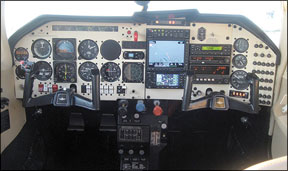
pounds, although the high sill door makes it difficult to wrestle large objects into the airplane. Baggage capacity can be increased by folding the rear seat backs down together or individually.
Mooneys are fast and efficient because they have low-drag airframes with a small frontal area. That translates into cramped quarters. The seating position is quite different from that of most airplanes. Its more of a sports-car posture than an upright seating regime. There’s plenty of leg room fore-and-aft, but less lateral room. Those of below-average height may find that they cant reach the rudder pedals without a booster cushion behind their backs or pedal extensions.
Early Mooneys tended to be Spartan in interior arrangements. But by the time the 231/252 appeared, Mooney recognized the need for more modern if not luxurious appointments. Thanks to a bit more elbow room and somewhat plusher finish, the 252 is more comfortable than the 231. The 252 is also quieter and many feel its the quietest of all Mooneys, thanks in part to the induction system and the fact that things quiet down the higher you fly.
The panel layout is quite good, with one seemingly obvious feature that has probably averted many incidents: The gear selector is located high in the middle of the panel so its hard to miss. The flap switch is located low on the center console, along with the trim/flap indicators and, in the 252, cowl flap controls.
The power gauges are on the far right and angled toward the pilot. Engine gauges are well-placed, right under the glareshield in front of the pilot. The panel also has a good selection of annunciator lights at the top of the radio stack.
Maintenance
Airframe-wise, Mooneys are relatively trouble-free. Long-standing caveats include the potential for corrosion of the cabin frame tubes-particularly if the windows develop leaks-and the typical fuel tank leaks that plague all Mooneys. Systems in general are simple and robust. The steel gear legs gear have no oleo struts, relying instead on rubber donuts for shock absorption. These need to be replaced periodically. There’s no complex electro-hydraulic system driving the gear as is found on Cessnas-Mooneys are electro-mechanical. The flaps, too, are electric, both are relatively trouble-free.
The powerplant, however, is another matter. Difficulties fall into several categories: magnetos, con rods, cylinders and turbos. Most airplanes have been retrofitted with pressurized mags but check any used model to be sure. The same applies to connecting rods. The suspect rods are Continental part number 626119 and have a C logo with a circle around it. Only a barn dweller would still have the old ones.
Many turbocharged models encounter mid-run cylinder problems of some sort and the K-model is no different. These include the full litany: worn valves and guides, broken rings and cracked jugs. Mid-time turbo and magneto replacements arent uncommon, but they arent a sure bet, either. The 231s fixed wastegate means the turbo is working constantly and the engine is susceptible to overboosting.
The 252 doesnt suffer these problems, although it had trouble with cracked tubes in the induction system before Continental came up with flexible tubing. Even though the 252s engine installation is less troublesome than the 231, temperatures and stresses on turbocharged engines are greater than on normally aspirated engines. Regular inspections and proactive maintenance is a must for reliable dispatch rates.
Mods, Clubs
By far the most desirable mods for the 231 are those that make it more like the 252. These include intercoolers from Aircraft Modifications, Inc. (253-851-6440) and the Merlyn Black Magic upper deck controller; contact www.merlynproducts.com or 800-828-7500. Both work as advertised and help eliminate the 231s engine problems. They also make the 231 perform almost as we’ll as a 252. We consider the Merlyn a must-have for the 231.
There are fewer speed mods for the K-model than for earlier Mooney types, such as the C, F and J models. Single-piece belly skins, minor speed mods, rudder and elevator hinge covers and oversized bushing kits for the nose gear are available from Lake Aero Style and Repair (www.lasar.com, 800-954-5619).
Precise Flight (www.preciseflight.com, 800-547-2558) offers speed brakes for the K-models. LoPresti Speed Merchants (www.speedmods.com, 800-859-4757) has an HID landing light for K-model and hub caps with filler valve access holes.
Mooney Mart claims to sell a range of speed mods, including gear doors and aileron gap seals. Contact www.mooneymart.com or 941-484-0801 to see if these mods are still active. Mod Works, another well-known Mooney house, retains some 39 STCs for Mooneys. However, the facility was wiped out during Hurricane Charley in 2004 and is out of operation indefinitely. Mod Works can still be reached at 941-637-6770.
A big dollar mod, the Rocket conversion, replaces the TSIO-360 with a 305-HP Continental TSIO-520-NB, yielding 220-knot plus cruise speeds. Although the conversion is
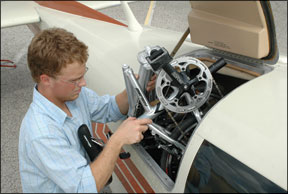
discontinued, these turn up on the used market. Contact www.rocketengineering.com. The thirstier engine in that mod will benefit from larger fuel tanks. Monroy Aerospace (www.monroyaero.com) has an STC to raise capacity to 106 gallons. Hartzell offers three-blade prop conversions (www.hartzellprop.com).
Currently, there are two Mooney Associations, the Mooney Aircraft Pilots Association and Mooney Owners of America. Both have membership benefits, technical support and magazines. Contact MAPA at www.mooneypilots.com and MOA at www.mooneyowners.com.
Owner Feedback
In 30 years of flying, Ive flown a wide variety of single-engine aircraft. Ive always been impressed with Mooneys and previously owned an M20E model. Eight years ago I acquired a turbocharged Mooney 252 and it is without any near comparison, the finest aircraft Ive ever flown. Mooneys are known for speed. Professional test pilot data reveals average speeds at 5000 feet of 168.5 knots, 184 knots at 12,000 feet and 191 knots at 18,000 feet.
The 252 is a highly maneuverable airplane and once one masters some of the intricacies of flying a high-performance aircraft, it is easy and forgiving in flight. The only area where it is somewhat unforgiving is in managing approach speed in landing. Mooneys are floaters, so if you are only a few knots too fast in landing, you’ll watch the runway sail by underneath while you hang in the air. Also, the 252 is not a big load hauler. If you wish to carry four people you’ll either have to put them on a diet or offload fuel.
The M20K -252 comes with speed brakes, built-in oxygen, dual alternators, back-up vacuum system, and prop deice. The TSIO360-MB1 engine in the 252 runs cool, smooth and is one of the easiest engines to start; often one blade of turn.
Unlike the 231, it requires no incremental advancement of the throttle to prevent overboosting. Fuel consumption in cruise is usually 12.8 to 13.1 GPH. Not bad for a high-performance, high-flying speedster. The expense of annuals have varied widely from about $2000 to $25,000, however, my estimate is an average of about $4000 here in the Northeast. There have been no recurring maintenance headaches. Insurance has run $2300 to $2700. Ive had to seal tanks on the 252 and on the earlier M20E, and this is one common fault with Mooneys.
In terms of raw speed, fuel economy, reliability, maneuverability and ability to perform we’ll in a wide altitude envelope, the Mooney 252 simply shines. A total of 231 of these aircraft were built and were then replaced by the slightly faster, less fuel efficient, more maintenance-hungry Mooney Bravo. To cite former Mooney test pilot Bob Kromer, “The 252 is simply one of the top Mooneys ever built.”
Bob Motta,
Melville, New York
I purchased my 1980 M20K, 262 conversion [231 with MB engine mod] in April 2008 and could not be happier. I wanted a 252 but was deterred by the price, but once I determined the 262 conversion would give me all the 252 capability at a lower cost, I monitored the ads until N231NL came on the market in January 2008.
My main mission is flying from the San Francisco area to the San Juan islands in Northwest Washington, and sought a plane to make the 670-mile flight nonstop and under four hours with two people and minimal baggage.
I fly mid-teens and have been to 19,000 feet on occasion, topping weather. All but local flights are IFR. I climb at 800 FPM at 110 to 120 KIAS, then cruise at 175 KTAS and 13 GPH at 16,000 feet with CHTs between about 330F to 385F.
We stay out of convection, but are often in clouds. It is, after all, the Northwest and ice is a factor year round. The few times that ice accumulation required an escape plan, the turbo performance allowed us to climb back out without a problem.
I previously flew a Mooney M20E, what I would call the Mooney
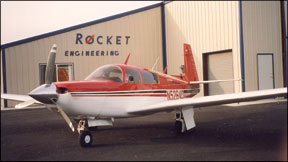
sports car. The 252 is not as quick on the controls as the M20E and has more longitudinal stability, which seems to be just about neutral.
This plane opens up the teens for routine travel, a region practically devoid of other traffic, such that you can go direct most of the time, almost always with no turbulence whatsoever. The payload isn’t all that great, but if youre fortunate enough to have a later model 252, there’s an STC permitting an increase in gross weight for the same exact engine/airframe combination as my Mooney 262.
Scott Burkhart,
Livermore, California
I have been the proud owner a 1986 M20K 252 S/N 25-1024, for the past three years. When I purchased the plane in 2006, it had been grounded with a seized engine and various other mechanical shortcomings. I had the engine removed, rebuilt and reinstalled.
I flew the airplane to Evanston, Wyoming for further reconstruction. The project included new avionics (Garmin 530/430 stack, 330 transponder, 340 audio panel, JPI 930 engine monitor, rebuilt steam gauges), new gear discs, new interior, new windows and a complete inspection and repair of all systems. I have been very pleased with the updates and navigational capabilities of the airplane.
Living in the Mountain West, a turbocharger is a plus, enabling plane and occupants to climb safely above threatening peaks. The 252 is at home here, while its low-altitude performance is acceptable, it was designed to fly high. At 73 percent power and 15,000 feet, the airplane conservatively turns in 180 knots on 12 GPH.
Perhaps the most prevalent complaint I hear about Mooneys is their landing characteristics, and maybe those complaints are we’ll deserved. The slippery Mooney does not lose speed quickly, especially in ground effect. Good speed management and patience are required to avoid a multitude of landing pitfalls..
My biggest complaint is useful load. With full fuel of 74 gallons I have 360 pounds of precious useful load, which too often is not nearly enough.
Annuals have averaged $3000, a bit higher this year because of leaking pushrod tubes. Insurance is in the neighborhood of $2100 annually. Useful load complaints aside, the 252 is a wonderful aircraft. Fast, efficient and predictable. Its always ready to go when I am.
Bob Holt,
Salt Lake City, Utah

